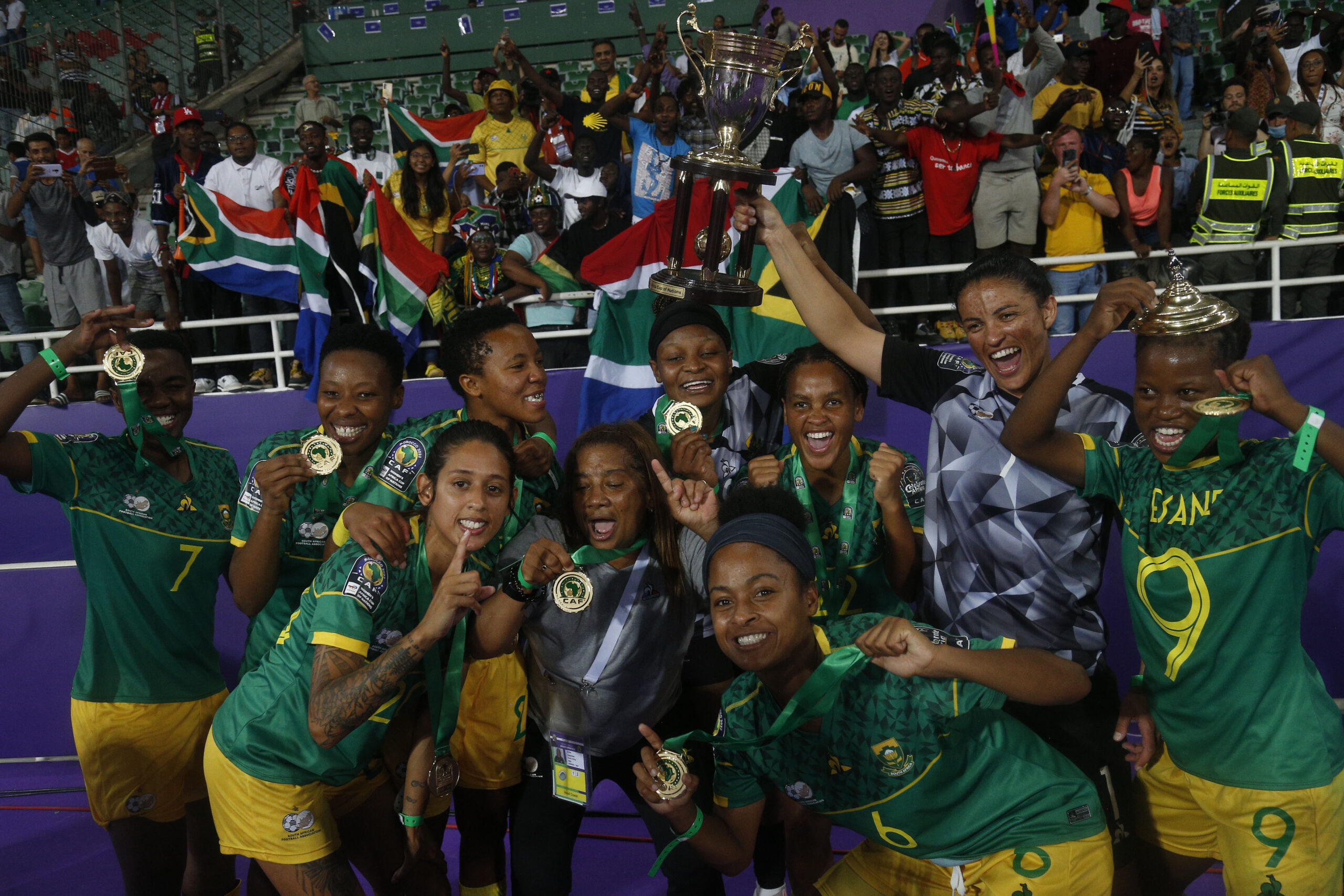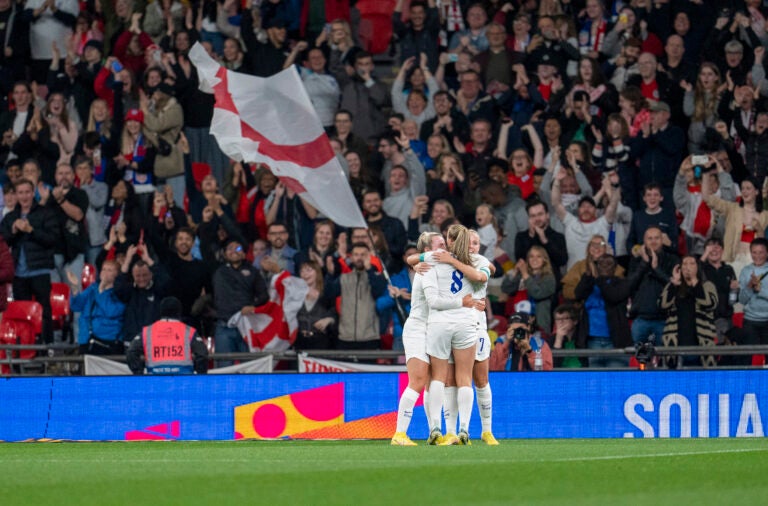Beyond the World Cup: Women’s Football Is Growing Throughout the Middle East and North Africa
Why this matters
As Qatar's football program took center stage at the men's World Cup in 2022 while Morocco became the first African country in a men's World Cup semifinal, global football fans got a glimpse of the tremendous growth of the sport in the MENA region, especially among women.
Political expression and protests were constants at this year’s men’s World Cup, as constant as exuberant fans and exciting matches. Palestinian flags were flown, and Iranian protesters objected to the mistreatment and abuse of women by the regime at home. In defiance of the host nation, fans and players flouted rules against wearing symbols supporting LGBTIQ communities, and organizations illuminated the years-long abuse of labor while Qatar prepared for the tournament.
The activism surrounding the men's World Cup wasn’t surprising. Sport provides an excellent platform to reflect upon society. But largely missing from this year’s World Cup was any meaningful discussion of gender and the impact of women’s football in the Gulf states, Middle East, or North Africa. There was little about women as players or fans in the regions or their connections to football except for how Western women positively experienced the tournament as fans from abroad.
Women’s football is growing all over the world, and campaigns for justice and access to the sport are stronger than ever on a global scale. I knew this. For the past 10 years, I have been one of the only journalists in North America to cover issues facing Muslim and Arab women in sports, from Iranian women not being allowed into stadiums to hijab bans in football by the French Football Federation to analysis of the growth of women’s football.
Missing from this year’s tournament was an incredible story: the growth of women’s football in nations that have struggled to advance women’s football in the past. Women’s football may not have appeared under the intense lens upon the Middle East and North Africa (MENA) at this year’s men’s World Cup, but with the women’s World Cup just seven months away, it could soon take center stage.
The History
Football media have repeatedly stated that Qatar 2022 is the first World Cup in the region. This is unequivocally untrue. The first FIFA World Cup in the Middle East was held in Jordan in 2016; it was the Under-17 Women’s World Cup. The language around the reporting is essential here because it erases how much the women’s game has grown and developed in the Middle East.
As Morocco advanced beyond the group stages and went to the semifinals as the first African and Arab team ever to do so in this year’s men’s tournament, there was little acknowledgement that the women’s team was runner-up to South Africa in the 2022 Africa Cup of Nations (also hosted by Morocco) and qualified for the 2023 Women’s World Cup for the first time.
The success of the Morocco women’s team was no accident. In 2020, the Royal Moroccan Football Federation unveiled a four-year plan to develop a strong women’s program that they hoped would dominate Africa. Currently, Morocco is the only country in the world to have two tiers of professional women's football, including access to world-class complexes.
In the Middle East, Jordanian women’s football has been advancing at a steady pace. In the early 2000s, several teams were created by women in Amman. Jordanian women received little support from society at large, but that changed after Prince Ali Bin Hussain threw his support and resources behind women’s football and football development. Bin Hussain was a core part of the team that campaigned to lift FIFA’s hijab ban, which was formally struck down in 2014. After the Iranian national women’s program was established in 2005, Bin Hussain went on to create the Asian Football Development Program, which amplifies women’s football in Middle Eastern and Gulf state countries as members of the Asian Football Confederation.
My friend Haneen Khateeb, 27, played for Jordan and has participated in global efforts including Equal Playing Fields’ world record for playing at the lowest altitude ever near the Dead Sea. She works in sports development as a technical advisor and is an advocate for gender equality in football. Khateeb says that opportunities for Arab women in football have increased steadily.
“Maybe it’s not a fast process and not everyone can observe it, but surely it’s effectively improving,” Khateeb says. She feels that the World Cup has had a positive impact. “I have seen so many [football-related] social and leadership programs that gave the chance for hundreds of women and girls from Qatar and the region to participate in and speak in their own voices … as well as seeing women leading the organizing committees and working hard to make the World Cup a success.”
Samar Nassar is the General Secretary of the Jordan Football Association, making her the first woman to head up the football association for a Middle Eastern nation. Khateeb says that also leaves a legacy. “Of course, this position comes with some cultural challenges,” she adds. “But at the same time, she’s easing the path for the upcoming female leaders.”
It’s not surprising that Nassar, a two-time Olympic swimmer, was selected to hold a senior position in the JFA. She has over 20 years of experience in the sports world and was the CEO of the organizing committee of the U17 2016 Women’s World Cup. Her role will cause a necessary disruption in a male-dominated realm, and her presence can encourage other young women to follow suit.
Qatar
When I went to Qatar to cover this year’s FIFA men’s World Cup, I met with several women from the Middle East and Gulf Region to talk football. As a Muslim woman, I have long felt that Western media doesn’t believe Muslim women are interested in or valuable to football, based on a lack of reporting and the disingenuous manner in which any reporting is done. Yes, women’s football in the MENA region does not have programs compared to the current women’s football superpowers of Canada, the United States, and England. But football has always been the most popular sport in the region. It could be said that the women’s football program in Qatar is on life support after almost eight years of inactivity, but there is more to building a successful football program than simply creating a roster of players.
Over coffee in a beautiful cafe in Katari Cultural Village, I spoke with Alexandra Chalat, Director of World Cup Legacy at the Qatar Foundation (QF), and Malak Elmoh, a 23-year-old student. While Elmoh is not Qatari, she has lived in Qatar for more than 14 years and has attended Georgetown University at the Doha campus.
According to its website, the Qatar Foundation is “a not-for-profit organization where centers and programs focused on education, research and innovation, and community development intertwine for the benefit of Qatar, and the world.” It is a government-funded organization that partners with institutions from around the world and offers education-centered programming and opportunities. And part of that programming includes women’s sports.
Qatar has been criticized for not boasting an existing women’s football program, but Chalat explained that an entire ecosystem of women’s sports needs to be created before a national team can exist. QF’s senior leadership team is mostly women. They have been implementing sports programming at grassroots levels for girls and young women that is grounded in research on health and well-being. They are creating pathways to coaching in sports including paddle ball. which according to Chalat is widely popular in the small country.
Chalat has been with the Qatar Foundation for two years. I asked her about the pockets of women’s football growth happening in Qatar. “Mainstream growth is happening,” she replied. “It’s not pockets of growth. It’s not little diamonds you find here or there. It’s the focus of the country — straight from leadership.” Chalat says that QF was founded 25 years ago to focus on “progressive and disruptive education” at its various schools and campuses.
Sports came to be a focus in QF’s planning and execution because of the way athletics are connected to mental health and community growth. But focusing on sports meant creating opportunities for women and girls, and that meant meeting the needs of women and girls in Qatar. Chalat and her team have identified many challenges for women and girls in sports in Qatar. Among those challenges are proper facilities, consistent programming, technical and administrative role creation, and appropriate sports apparel.
Related: Having Beaten the Pandemic, the NWSL is Promoted to Big Leagues
The term “women-only spaces” refers to a physical space that offers women as program coordinators, instructors, referees, staff, and administrators and that serves women. The reason women-only spaces are needed is that Qatari women may not want to cover while exercising. If they observe Islamic dress and cover in front of men, they would have to be covered while they exercise in a mixed-gender facility. Some women would feel more comfortable without men around, and the popularity of women-only gyms is not a phenomenon only in Muslim countries.
Women-only spaces need to be created in sports facilities under terms dictated by Qatari women. There has been an explosion of participation, and quite often sports spaces for women are booked up.
Elmoh explained that along with excitement in the country about sports because of the World Cup, there is a definite interest from women in holding positions of leadership and using sports as a vehicle for advancement in society. Elmoh also explains that there is a deep connection to football in Qatar, and women are not removed from that.
“But it will be on the terms of women in Qatar,” she explained. As the small country grows, Qatar Foundation is cognizant that women should dictate the terms of how they want to access the programs.
Qatar Foundation’s plan is to use the facilities of Education City – a 4.6-square-mile (12 km) area in Doha with world-class facilities that are home to Aspire Academy – as a possible base of operations for the women’s national football team. Aspire Academy hopes to train young athletes and become a force in the global sports scene, but as of right now, the academy has no specific program dedicated to women’s football. The plan isn’t perfect, and it absolutely needs to be nurtured and invested in, but the energy and enthusiasm with which both Chalat and Elmoh explained the projects made me think about the work in women’s football around the world. It has to start somewhere. There must be vision and invigorating ideas, and there must be action.
The Legacy
In examining women’s football, it is important to not assume that sports exist in other countries the way that they do in the Global North. Football has existed for a very long time, and. of course, women have been fans. They have not, however, always been permitted to attend matches in public spaces.
In 2013, the first women were permitted into stadiums in Bahrain when the country hosted the 21st Gulf Cup of Nations, and Saudi Arabia followed suit at the beginning of 2018. The rise of football in Saudi Arabia has been fascinating to witness. On a 2018 episode of “Burn It All Down,” I discussed why the changing landscape in Saudi Arabia is important and why grassroots movements have been occurring in that region for a while. In the episode, I stated that allowing women into stadiums and to participate publicly in sports has a ripple effect on society at large:
… in addition to creating jobs for women, like ushers, food service, etc., it actually creates the visibility of women in public and family spaces, which was severely lacking before and still remains to be a huge challenge.
The Saudi Arabian domestic league was not created overnight. Women rallied for it and built foundations for generations to come. I spoke with Bireen Sadagah, who plays in the Saudi Women’s Premier League Arabia, which was established in 2022, and before that played in the Jeddah Women’s League. The 35-year-old has played football for decades and told me that she has seen a tremendous increase in support for women’s football in Saudi Arabia.
“The experience is great and continuously increasing,” Sadagah says. “There’s no limits for us to improve and show the world what Saudi Arabia can do.” Saudi Arabia also kicked off its national women’s program in the fall of 2021. The Saudi Arabia Football Federation asked storied German coach Monika Staab to offer licensing courses for women. After that successful program, SAFF asked her to stay on as head coach of their newly minted team in 2022.
Previously established clubs in Saudi Arabia like Al-Nasser, Al-Ittihad and Al-Ahli have encouraged young women to take up football not only as a pastime but perhaps as a profession. The Saudi Arabian men’s team beating Argentina in the group stages at Qatar 2022 certainly put this fairly unrecognizable football nation on the map. The victory was labeled “the greatest upset in World Cup History.” The energy and excitement of that win can be framed as a powerful tool for women while they are building their own football space. They can argue that the humble national program beat the best player in the game and the team that eventually won the World Cup. Those are certified bragging rights.
Related: What Women’s Soccer Can Learn From Barcelona and Lyon’s Dueling Dominance
Football in other Gulf states has also been growing. The United Arab Emirates have never fielded a team in the men’s World Cup, but they have the drive and willingness.
Omar Al-Duri, an award-winning coach and a football commentator, is working to push women’s football in the Emirates. Al-Duri has coached the under-15, under-19, and senior women’s teams of the UAE Football Association. The London-born, self-proclaimed Arsenal fan has been engaged with grassroots teams, University-level football, and semi-professional and national teams. Al-Duri’s wife, Maria Khan, is the Pakistani-American captain of the Pakistan Women’s National Football team. This power couple are not strangers to supporting the women’s game on a global level.
Khan plays in Division One of the women’s professional league in Dubai; Division One has five teams, and Division Two has four teams. Division One comprises Academy and women’s teams, and among them are many ex-pat players. Currently, not all the players are paid for their participation.
According to Khan, the UAE FA is looking for men’s licensing for men’s clubs, but part of that requirement for licensing by the Asian Football Confederation now requires that countries show investment in women’s programs, too. Khan adds that the challenge is that not enough women want to play football professionally.
“There’s simply not enough Emirati (women) for each professional club to have a team," Khan says. "And if you are to bring in foreigners, the rules that the league have is that you aren’t allowed to have more than two foreigners per team.”
"Foreigners" are classified as players who have represented their national teams. The Gulf and Middle Eastern majority of the league’s players have represented their national teams, so they automatically qualify. There are gifted expat players from the United States, Canada, South America, and Europe, but again, outstanding women may not be willing to commit to full-time professional football.
“It is very much in its infant stages,” says Khan. Like all of the women’s football in the world, sustainability and consistency are important. The UAE FA is trying to create and implement a plan, but doing so is taking time. The players pay a small fee, but there is funding for transportation, qualified referees, and premier facilities. In the UAE, there must be five Emirati players on the field at all times. But the league is growing, and the men’s World Cup has played a part.
“The fact that girls are now women and representing the country and I am able to go to the FA and watch the women play as a fan fills me with joy!” Al-Duri told me over email. He pointed out that the infrastructure exists in the UAE to support women. “Footballers come to the UAE from all around the world for the pre-season, international break, and warm-weather training, so it’s clear it has the resources and facilities to accommodate the best of the best.”
Just as Arab women are not a monolith, neither are the statuses of their football programs. Some are thriving; some are just beginning to grow. Football is the most popular sport in the world, and each country and region will have not only its own flavor but also its own cultural contributions.
As we approach a Women’s World Cup year, the developments in women’s football are ones that we should keep watching. The love of football is not gender-specific, nor is it dictated by country or class. This is truly the world’s game. If women in the Middle East wish to play, develop programs, or run football organizations, it is necessary to support those endeavors and make way for new guardians of the game.
Monthly Issue
The World of Football
The Qatar World Cup looks destined to be a debacle, from the scheduling for teams and athletes to the human rights abuses around workers at the event, to the logistics and after-effects of holding the event itself.
At the same time, soccer is changing like all sports – becoming more cross-pollenated between cultures and nations, maneuvering through a massive influx of cash, and modernizing on and off the pitch.
We offer a look at the state of world football through the lens of the 2022 FIFA World Cup.




